Dressed in white and tapping their staffs on the ground to summon ancestors, four dancers from the Kumbuka African Drum & Dance Collective strode down Oretha Castle Haley Boulevard in New Orleans to correct a century-old narrative.
Ausettua AmorAmenkum, a Kumbuka founder, stopped at the downtown side of a new historical marker at the Martin Luther King Jr. Boulevard intersection to offer prayers to the ages. As the blue tarp was removed from the two-sided cast aluminum plaque, she intoned: “To all those unknown whose names did not make it into the history books.” The crowd chanted back, “Ashé,” using the Yoruba word that is a rough equivalent to “amen.”
Above the heads of the dancers and drummers, the plaque’s lesson, headlined “Mass Lynching in New Orleans,” describes the four-day “campaign of racial terror” in July 1900 during which White mobs roamed the city preying on Black people and killing at least seven, including Hannah Mabry, 60, and Robert Charles, 35, the Black man whose thwarted arrest had spurred the unrest.
Like the removal of the Confederate monuments and the expungement of slaveowners’ names from schools and streets, Wednesday’s ceremony was intended both to set the historical record straight and to face racism that still exists in New Orleans.
“It could happen again today. It does happen today. It’s the same thing over and over,” said Queta Beasley Harris, 45, who recently learned that Mabry was her great great great great grandmother on her father’s side. Mabry was killed by a gunshot to the lung, as rioters pulled off the shutters of the family home on Rousseau Street, one of the only Black-occupied houses in that area. The mob shot 40 to 50 times into the home, then set it on fire, said Stephen Prince, a University of South Florida history professor, who has written a book about the tumult, “The Ballad of Robert Charles,” to be published in 2021.
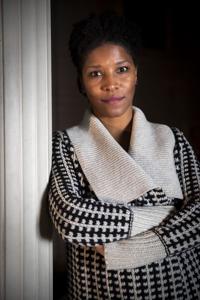
Queta Beasley Harris poses outside her home in New Orleans, Wednesday, Dec. 16, 2020. She is the great great great great granddaughter of Hannah Mabry, who was shot and killed in 1900.
Harris hopes people who visit the plaque will understand that her ancestor was someone “who has descendants who love her and carry this pain, this burden, with them because someone saw her only for the color of her skin. They thought they could erase her.”
The text on the shiny plaque summarizes how the violence began: “On July 23, white policemen confronted Mr. Charles while he was seated peacefully on a doorstep. Mr. Charles objected, struggled, and ultimately fled after multiple exchanges of gunfire, leaving two officers dead. In response, thousands of armed white people, shouting, ‘kill the negroes’ gathered at Robert E. Lee Circle seeking to attack Black people. Over several days, white mobs shot, beat, and killed Black people in a terror crusade to maintain white supremacy.”
“People think the Jim Crow era was about legally segregated bathrooms and water fountains and schools. But it was also unapologetically bloody,” Prince said. “And the summer of 1900 was a deeply violent time for race relations in the United States, particularly in the South. Blacks were losing the right to vote, and it was the peak of lynchings.”
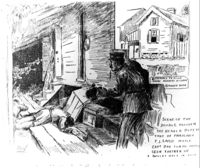
The bodies of two police officers lie alongside the New Orleans house where they went in 1900 to arrest Robert Charles for killing two other officers. (Illustration from The Historic New Orleans Collection)
In New Orleans, the mobs that roamed the streets were not ultimately looking for Charles or even trying to avenge the deaths of White police officers, Prince said. “It was violence for violence sake. It was about control, about affirming that New Orleans was a White man’s city and that acts of transgressions like Charles’ were not acceptable.”
But Charles, a skilled marksman, kept police at bay. Prince summarized what happened:
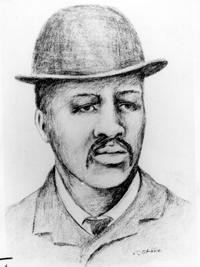
Robert Charles
After Charles wounded officers on Dryades Street, between Washington Avenue and Sixth Street, he killed two other officers who had tracked him to the room he rented on Fourth Street early in the morning of July 24. He laid low until police found him on July 27 at 1208 Saratoga St. As two White officers entered the house, Charles shot them dead then fled to the second floor.
The gunfire drew a crowd and Charles continued to shoot, killing three more White men, perhaps some of 1,500 volunteers who were deputized by the mayor to quell four days of violence. To smoke Charles out, the house was set afire. Charles fled out the back door and was shot and killed. The crowd stood over him, emptying their guns into him and beating and kicking him until his features were unrecognizable, Prince said. “People thought he had died too easily.”
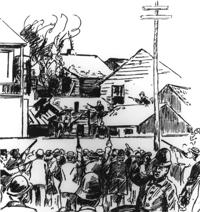
A crowd rallies outside the frame building at 1208 Saratoga St. in New Orleans where Robert Charles was holed up until he was forced out by the flames and killed on July 27, 1900. (Illustration from The Historic New Orleans Collection)
As demonstrated by the Uptown side of the marker, headlined “Racial Violence in America,” Wednesday’s ceremony and the marker itself are part of a national effort to acknowledge that widespread Jim Crow-era racial violence killed thousands of Black people in the United States between 1877 and 1950.
Across the country, the effort is spearheaded by the Equal Justice Initiative and the National Memorial for Peace and Justice in Montgomery, Alabama. In New Orleans, a group of volunteers called the Orleans Legacy Project has worked for two years to plan the marker’s text and installation. Students of Xavier University art professor Ron Bechet also helped with key parts of Wednesday’s event, in an effort to bring light to “a part of our history that we’ve tried to keep concealed.”
An edited recording of the ceremony will be shown Saturday at 10 a.m. via Zoom.
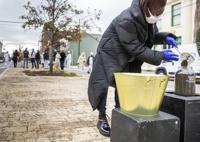
Xavier student Antwamesha Jenkins pours soil into a jar from the location of where Hannah Marby was shot and killed in 1900, during the unveiling of the historical marker on Oretha Castle Haley Boulevard in New Orleans, Wednesday, Dec. 16, 2020.
Other parts of the local initiative include an upcoming school-essay contest, more historical markers and a performance in January of “Waiting While Black,” a play about Robert Charles. It grew out of a Xavier-Tulane University class that Bechet teaches jointly with Barbara Hayley of Tulane.
During Wednesday’s ceremony, three commemorative urns were filled with dirt that had been dug from Hannah Mabry’s yard. One will be placed at the memorial in Montgomery, and one will be delivered to Harris, the Mabry descendant, during Saturday’s Zoom ceremony. The final urn’s destination is still being decided.
Harris, the Hannah Mabry descendant, learned about Charles more than two decades ago, when she was a 19-year-old student taking a University of New Orleans history class taught by civil rights icon Raphael Cassimere Jr. “He knew the story and was passionate about it. It felt local and so close,” said Harris, who was surprised that she hadn’t heard it earlier because her father, Jack Gordon, had been a Black Panther and civil rights activist.
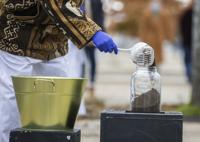
Shaka Zalu pours sand into a jar from the location of where Hannah Marby was shot and killed in 1900, during the unveiling of the historical marker on Oretha Castle Haley Boulevard in New Orleans, Wednesday, Dec. 16, 2020. (Photo by Sophia Germer, NOLA.com, The Times-Picayune | The New Orleans Advocate)
Then she discovered, through a letter from Prince, that the community history she’d learned was her own history as well. “It made me feel more deeply intertwined with the history of this country, with racism and lynching,” Harris said. “I feel responsible for my ancestor’s legacy.”
For Cassimere, 78, the 1900 race riot always felt fresh. He had grown up hearing stories about it from his maternal grandmother, who was 28 at the time of the massacre. He said the narrative was kept alive in local Black households, which often quietly acknowledged Robert Charles as a folk hero, someone who had stood up for his rights.
In 1938, jazz pianist Jelly Roll Morton told interviewer Alan Lomax what he knew about Robert Charles, a back-to-Africa activist who sold newspapers for a living. “Robert Charles was very orderly … never had any trouble before. But this [the police confrontation on Dryades] arose him to fury,” Morton said.
Relatives also told the story to Shaka Zulu, 51, big chief of the Golden Feather Hunters tribe of Black masking Indians, often called Mardi Gras Indians, who played in the Kumbuka collective Wednesday. Zulu and Malik Bartholomew, 39, of Know Nola Tours, said Charles’ name often crops up in the Indian chants that are passed from one generation to the next.
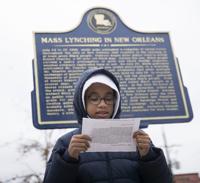
Jibril Abdullahi, 11, reads about lynchings that occurred in New Orleans in 1900 during the unveiling ceremony of the historical marker on Oretha Castle Haley Boulevard in New Orleans, Wednesday, Dec. 16, 2020.
As Zulu played his drum, two 11-year-olds, History Ecclesiastes and Jibril Abdullah, stepped forward to read the text from the plaque to the audience. Later, the two of them helped to transfer the soil from Mabry’s yard into urns and explained how that activity, too, helped to make things right.
“We’re helping out a soul,” History said. “Because we know that she’s watching and that we made her happy.”
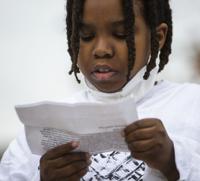
History Ecclesiastes, 11, reads about lynchings and violence that occurred for 4 days straight in 1900 during the unveiling of the historical marker on Oretha Castle Haley Boulevard in New Orleans, Wednesday, Dec. 16, 2020. (Photo by Sophia Germer, NOLA.com, The Times-Picayune | The New Orleans Advocate)
Those who wish to view the Saturday unveiling must register in advance through this link: https://us02web.zoom.us/meeting/register/tZMrfuihpj8tE9BHxHx9z3QNfBTblM6VG2vv
"correct" - Google News
December 16, 2020 at 03:00PM
https://ift.tt/38nMwYb
In Central City, new marker seeks to correct 120-year New Orleans narrative - NOLA.com
"correct" - Google News
https://ift.tt/3d10rUK
https://ift.tt/35qAk7d
Bagikan Berita Ini
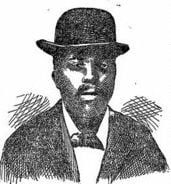














0 Response to "In Central City, new marker seeks to correct 120-year New Orleans narrative - NOLA.com"
Post a Comment